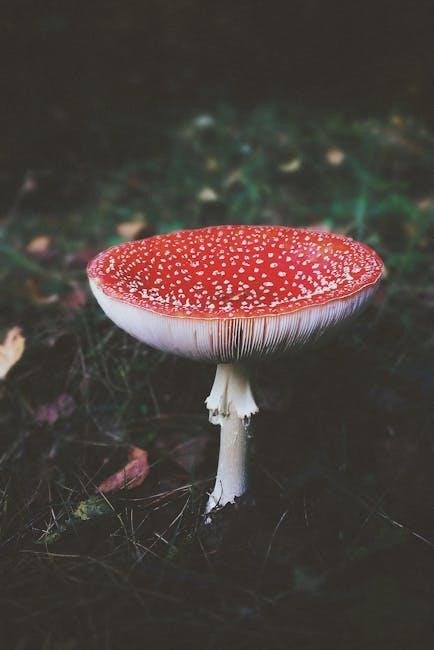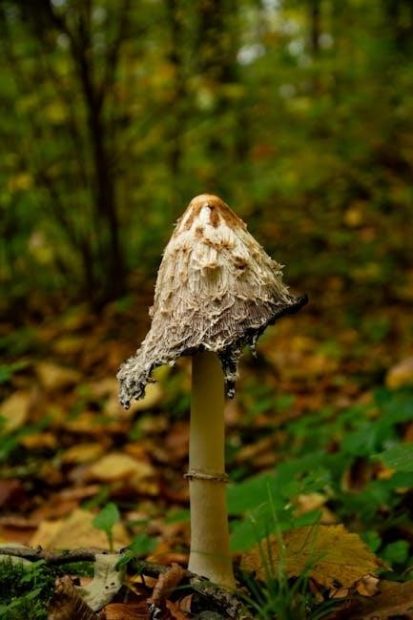Colorado offers abundant opportunities for mushroom hunting‚ with diverse ecosystems harboring a wide variety of species. This activity attracts both experienced foragers and newcomers‚ promising adventure and discovery.

Popular Edible Mushrooms Found in Colorado
Colorado’s diverse landscapes host a variety of edible mushrooms‚ including chanterelles‚ porcini‚ and morels‚ each prized for their vibrant colors‚ unique textures‚ and rich‚ earthy flavors.
2.1. Chanterelles
Chanterelles are among Colorado’s most sought-after edible mushrooms‚ known for their vibrant yellow to orange funnel-shaped caps and wrinkled‚ veined surfaces. They emit a fruity‚ apricot-like aroma and have a peach-colored interior. These mushrooms thrive in the state’s coniferous forests‚ particularly under pine and spruce trees‚ and are typically found from mid-summer to early fall. Chanterelles are prized for their rich‚ earthy flavor and firm texture‚ making them a delicacy in both wild and culinary settings. Their unique appearance and robust taste make them a favorite among foragers and chefs alike‚ though they can be challenging to locate due to their ability to blend into their surroundings.
2.2. Porcini
Porcini mushrooms‚ scientifically known as Boletus edulis‚ are highly prized for their rich‚ nutty flavor and firm texture. In Colorado‚ they typically grow in association with coniferous trees‚ especially pine and spruce‚ during the summer and early fall months. Porcini have a stout‚ stocky appearance with a brown cap that ranges from light to dark and a white or yellowish pore underside. They are considered one of the “Colorado Fab Five‚” making them a favorite among local foragers. Porcini are excellent for various culinary uses‚ including sautéing‚ roasting‚ and drying‚ and are a key ingredient in many traditional dishes. Their distinctive aroma and taste make them a standout species in the Rocky Mountain region.
2.3. Morels
Morel mushrooms are among Colorado’s most sought-after edible species‚ renowned for their unique‚ honeycomb-like appearance and delicate flavor. They typically grow in moist environments‚ such as near streams‚ in burned areas‚ or under deciduous trees like aspen and pine. Morels are highly prized for their rich‚ earthy taste and versatility in culinary dishes‚ making them a favorite among chefs and foragers alike. In Colorado‚ they often appear in late spring‚ with black morels being more common in higher elevations. Their elusive nature and limited season add to their allure‚ challenging even experienced foragers. Proper identification is crucial‚ as some lookalikes can be toxic. Morels are a true delicacy of the Rocky Mountains‚ offering a rewarding experience for those skilled enough to find them.
Poisonous Mushrooms in Colorado
Colorado is home to several poisonous mushrooms‚ including Amanita species and false morels. Proper identification is crucial‚ as misidentification can lead to severe health risks or death.
3.1. Amanita Species
Amanita species are among the most toxic mushrooms found in Colorado‚ with several deadly varieties growing in the state. Amanita muscaria and Amanita pantherina are common in the Rocky Mountains‚ often found near coniferous trees. These mushrooms are easily recognizable due to their striking caps‚ which are typically bright red with white spots or brownish in color. Amanita species contain powerful toxins that can cause severe illness‚ organ failure‚ and even death if ingested. They are responsible for the majority of mushroom-related fatalities worldwide. It is critical for foragers to exercise extreme caution‚ as Amanita mushrooms can resemble edible species. No part of these mushrooms is safe for consumption‚ and handling them requires care. Experienced foragers and novices alike must avoid Amanita species under all circumstances.
3;2. False Morels
False morels‚ belonging to the genera Gyromitra and Helvella‚ are highly toxic mushrooms found in Colorado. They often resemble edible morels but are deadly poisonous if ingested. These fungi typically grow in moist‚ wooded areas and near coniferous trees‚ especially during spring and early summer. False morels contain a toxin called gyromitrin‚ which can cause severe vomiting‚ seizures‚ and even liver or kidney failure. The brain-like appearance of Gyromitra esculenta is particularly deceptive‚ leading many novice foragers to mistake it for a safe species. There are no known edible lookalikes for false morels‚ and all species within this group should be avoided entirely. Proper identification is critical‚ as even small amounts can be fatal. Experienced foragers must remain vigilant to distinguish them from true morels.
Best Times and Places for Foraging
Colorado’s prime mushroom foraging occurs during summer months‚ with porcini and chanterelles thriving mid-July to September. Rocky Mountain forests‚ especially near conifers and aspen groves‚ are hotspots.
4.1. Seasonal Guide
Colorado’s mushroom foraging seasons vary‚ offering different species throughout the year. Spring brings morels‚ often found in moist‚ wooded areas. Summer‚ particularly mid-July to September‚ is ideal for porcini and chanterelles‚ thriving in coniferous and aspen forests. Fall sees oyster mushrooms and honey mushrooms‚ while winter offers fewer options but still yields some hardy species. Timing is crucial‚ as weather and elevation influence growth. Higher elevations may delay mushroom appearances‚ while lower areas can see earlier activity. Understanding these seasonal patterns enhances foraging success. Field guides and local expertise can further refine timing and targeting of specific species‚ ensuring a productive and enjoyable foraging experience across Colorado’s diverse landscapes.
4.2. Prime Foraging Locations
Colorado’s diverse landscapes provide numerous prime locations for mushroom foraging. The Rocky Mountains‚ particularly areas around Aspen‚ Steamboat Springs‚ and the San Juan National Forest‚ are hotspots for species like porcini and chanterelles. Lower elevations‚ such as the foothills near Denver‚ offer opportunities for morels and oyster mushrooms. Moist‚ wooded areas with coniferous or aspen groves are ideal‚ while higher elevations may require later summer visits. River valleys and meadows also host a variety of fungi. Local parks‚ such as those in Boulder and Colorado Springs‚ can be productive‚ though permits may be needed. Always ensure legal access and practice sustainable foraging to preserve these natural resources for future enthusiasts.
Safety Guidelines and Precautions
Mushroom hunting in Colorado requires caution to ensure a safe and enjoyable experience. Always prioritize proper identification‚ as some species can be poisonous. Consult multiple field guides or experts to confirm the edibility of any mushroom. Avoid eating mushrooms that are past their prime or show signs of decay. Wear gloves and protective clothing to handle fungi safely. Bring a basket or breathable container to store your finds‚ and never over-harvest to preserve the ecosystem. Stay hydrated and prepared‚ especially in remote areas‚ and respect private property rights. Be mindful of regulations and avoid picking in protected zones. Never consume mushrooms without absolute certainty of their safety‚ and consider joining a guided tour or class to learn from experienced foragers.

Mushroom Foraging Laws and Regulations
Mushroom foraging in Colorado is subject to various laws and regulations to ensure sustainability and public safety. On public lands‚ such as national forests and parks‚ permits are often required for mushroom collection. These permits may have specific limits on quantity and species to protect ecosystems. Seasonal restrictions may also apply to prevent over-harvesting during sensitive growth periods. Private property rights must be respected‚ requiring landowner permission to forage. Additionally‚ certain species‚ like psilocybin mushrooms‚ are regulated under state and federal laws‚ with recreational use restricted in some areas. Always check local ordinances and obtain necessary permits before heading out to forage. Adhering to these regulations helps preserve Colorado’s natural resources for future generations while ensuring legal compliance.

Tools and Equipment for Mushroom Hunting
Mushroom hunting in Colorado requires essential tools to ensure a successful and enjoyable experience. A good field guide is crucial for identifying species accurately. A sturdy knife or blade helps in carefully cutting mushrooms at the base to avoid damaging the mycelium. Ventilated baskets or bags are ideal for collecting mushrooms‚ allowing spores to disperse and preventing moisture buildup. Wearing comfortable‚ waterproof footwear and long-handled gloves protects against rough terrain and potential allergens. A magnifying glass or handheld microscope can aid in examining small features for identification. Additionally‚ carrying a GPS device or a reliable map helps navigate Colorado’s vast wilderness areas. Proper tools enhance both the efficiency and safety of your mushroom-hunting adventure.

Mushroom Identification Techniques
Accurate mushroom identification is crucial for safe and successful foraging in Colorado. Start by observing the cap shape‚ size‚ and texture‚ as well as the gill or pore structure underneath. Note the stem’s length‚ thickness‚ and any distinctive features like rings or volvas. Spore print color can also help narrow down species. Use a field guide or expert resources to cross-reference characteristics. Be cautious of lookalike species‚ especially poisonous ones like Amanita or false morels. Experienced foragers often recommend consulting multiple sources before confirming a mushroom’s identity. Practice and patience refine identification skills‚ ensuring a safer and more enjoyable foraging experience in Colorado’s diverse ecosystems.
Culinary Uses of Colorado Mushrooms
Colorado’s wild mushrooms offer a world of culinary possibilities‚ adding unique flavors and textures to various dishes. Chanterelles‚ with their fruity‚ apricot-like aroma‚ are perfect for sautéing with butter and herbs or pairing with wild game. Porcini‚ known for their rich‚ earthy flavor‚ are ideal for risottos‚ pasta dishes‚ or as a hearty addition to soups. Morels‚ prized for their delicate‚ honeycomb appearance‚ can be stuffed‚ battered‚ or simply sautéed in olive oil. Many species can be dried or frozen to preserve their flavor for year-round use. Whether you’re a gourmet chef or a home cook‚ Colorado’s mushrooms bring a touch of wilderness elegance to any meal‚ making them a sought-after ingredient in both traditional and modern cuisine.
Mushroom Conservation and Sustainability
Mushroom conservation and sustainability are vital to preserving Colorado’s diverse fungal ecosystem. Over-harvesting and habitat destruction threaten certain species‚ emphasizing the need for responsible foraging practices. Experts recommend harvesting only what is needed‚ avoiding over-picking‚ and leaving smaller mushrooms to mature. Protecting habitats by minimizing environmental impact during forays is equally important. Educational programs and guided tours promote awareness‚ encouraging sustainable methods. Additionally‚ supporting local conservation efforts and adhering to regulations help ensure that Colorado’s mushroom populations remain healthy for future generations. By embracing these practices‚ enthusiasts can enjoy the bounty of wild mushrooms while preserving their ecological role in the state’s forests and ecosystems.
Additional Resources for Mushroom Enthusiasts
Colorado mushroom enthusiasts can access a variety of resources to enhance their knowledge and skills. Books like the Essential Guide to Rocky Mountain Mushrooms and Mushrooms of the World provide detailed identification and foraging tips. Online communities‚ such as local mushroom clubs and forums‚ offer a platform to share experiences and learn from experts. Websites like Colorado Mushrooms feature species lists‚ cooking ideas‚ and conservation advice. Additionally‚ local cooking classes and foraging workshops are available‚ offering hands-on learning opportunities. For those interested in advanced topics‚ the Mushroom Research Institute and similar organizations publish scientific studies and host events. These resources empower enthusiasts to explore Colorado’s fungal diversity responsibly and effectively.
